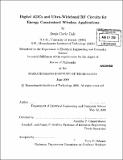Digital ADCs and ultra-wideband RF circuits for energy constrained wireless applications by Denis Clarke Daly.
Author(s)
Daly, Denis Clarke
DownloadFull printable version (35.88Mb)
Other Contributors
Massachusetts Institute of Technology. Dept. of Electrical Engineering and Computer Science.
Advisor
Anantha P. Chandrakasan.
Terms of use
Metadata
Show full item recordAbstract
Ongoing advances in semiconductor technology have enabled a multitude of portable, low power devices like cellular phones and wireless sensors. Most recently, as transistor device geometries reach the nanometer scale, transistor characteristics have changed so dramatically that many traditional circuits and architectures are no longer optimal and/or feasible. As a solution, much research has focused on developing 'highly digital' circuits and architectures that are tolerant of the increased leakage, variation and degraded voltage headrooms associated with advanced CMOS processes. This thesis presents several highly digital, mixed-signal circuits and architectures designed for energy constrained wireless applications. First, as a case study, a highly digital, voltage scalable flash ADC is presented. The flash ADC, implemented in 0.18 [mu]m CMOS, leverages redundancy and calibration to achieve robust operation at supply voltages from 0.2 V to 0.9 V. Next, the thesis expands in scope to describe a pulsed, noncoherent ultra-wideband transceiver chipset, implemented in 90 nm CMOS and operating in the 3-to-5 GHz band. The all-digital transmitter employs capacitive combining and pulse shaping in the power amplifier to meet the FCC spectral mask without any off-chip filters. The noncoherent receiver system-on-chip achieves both energy efficiency and high performance by employing simple amplifier and ADC structures combined with extensive digital calibration. Finally, the transceiver chipset is integrated in a complete system for wireless insect flight control. (cont.) Through the use of a flexible PCB and 3D die stacking, the total weight of the electronics is kept to 1 g, within the carrying capacity of an adult Manduca sexta moth. Preliminary wireless flight control of a moth in a wind tunnel is demonstrated.
Description
Thesis (Ph. D.)--Massachusetts Institute of Technology, Dept. of Electrical Engineering and Computer Science, 2009. Cataloged from PDF version of thesis. Includes bibliographical references (p. 173-183).
Date issued
2009Department
Massachusetts Institute of Technology. Department of Electrical Engineering and Computer SciencePublisher
Massachusetts Institute of Technology
Keywords
Electrical Engineering and Computer Science.